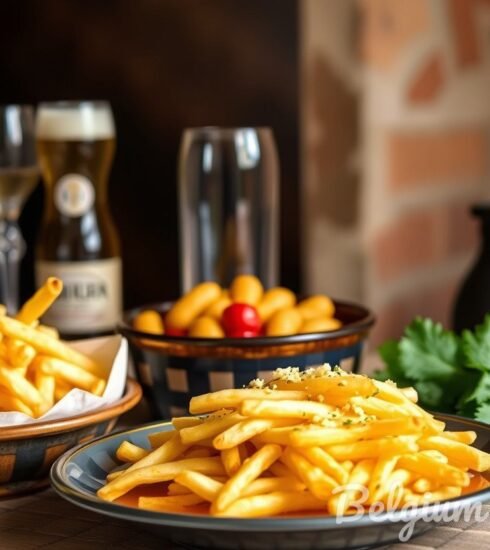Discover Belgian Culinary Secrets: Unearthing Belgiums Forgotten Bites and Rich Culinary Heritage
Beneath the Surface: Unearthing Belgium’s Forgotten Bites and Culinary Heritage
When one thinks of the culinary landscape of Belgium, the mind often conjures images of crisp waffles, rich chocolate, and delicious fries doused in mayonnaise. However, beneath this well-known facade lies a treasure trove of Belgian culinary secrets that remain largely forgotten.
The Roots of Belgian Culinary Heritage
Belgium’s culinary story is an intricate tapestry woven from its diverse influences. With a unique geographical position in Europe, Belgium has been a crossroads for different cultures and cuisines. This melding of traditions has created a distinctive culinary identity that is often overshadowed by more popular dishes.
A key characteristic of Belgian cooking is its regional diversity. Each province boasts its own specialties, born from local ingredients and culinary traditions. From the sea to the mountains, the landscape provides a bounty that feeds the Belgian palate. Ancient recipes have been passed down through generations, yet many of these dishes remain relatively unknown outside of their regions.
Regional Delights: Unearthing Hidden Gems
In the quest to discover Belgium’s forgotten bites, it’s essential to examine the culinary offerings from different parts of the country. Below are some regional delicacies worth exploring:
- Liège Waffles: Unlike their Brussels cousins, Liège waffles are denser and have a caramelized sugar crust. This unique preparation makes them perfect for a delicious snack on the go.
- Carbonnade Flamande: This traditional beef stew is cooked in a rich beer sauce, often served with crusty French bread. It reflects the Flemish love for beer, showcasing how local brews can elevate classic dishes.
- Welsh Rarebit: Believed to have originated in Belgium, this cheese dish has seen various adaptations across Europe. In Wallonia, it is often enhanced with local beers and spices, highlighting innovation in traditional cooking.
- Gentse Stoverij: A lesser-known beef stew from Ghent, it embodies a culinary approach that blends local ale with tender meat. This dish tells the tale of Belgium’s brewing culture through its rich flavors.

Historical Influences on Belgian Cuisine
Belgium’s culinary evolution has been influenced by numerous historical events. From Roman conquests to Spanish rule, every period brought new ingredients and techniques. The invention of chocolate in the 17th century, for instance, transformed Belgium into the world leader in chocolate-making. This wealth of history adds depth to existing dishes and is essential for understanding the country’s culinary secrets.
The Role of Beer in Belgian Cooking
Belgium is renowned for its beer; in fact, the country boasts over 1,500 different types of beer. The usage of beer in cooking isn’t merely about flavor; it’s traditional and has roots in peasant cooking. Here are a few dishes that beautifully integrate beer:
- Beer-Braised Mussels: Mussels cooked in Belgian ale create a unique seafood experience, marrying the briny freshness of the ocean with the rich, malty flavor of beer.
- Beer Soup: A rustic dish originating from rural areas, beer soup combines stale bread with assorted spices and, of course, beer.
- Tongue in Beer Sauce: Cooking tongue in a robust beer sauce reflects the Belgian understanding of using local products in delightful ways.
Market Trends: Reviving Forgotten Flavors
Modern culinary tours are beginning to highlight Belgium’s forgotten dishes, bringing attention to what was once lost. With the rise in sustainable dining and food tourism, chefs are experimenting with ancient recipes, giving them contemporary twists while retaining traditional flavors. This is evident in various culinary festivals and events across the country.
Case Studies: Modern Revival of Forgotten Dishes

Numerous restaurants in Belgium have taken it upon themselves to revitalize traditional recipes. For example:
- Restaurant De Fonderie: Located in Brussels, this restaurant specializes in forgotten Belgian dishes. Their menu features items like Stoemp, a dish of mashed potatoes mixed with vegetables, highlighting local agriculture.
- Het Pomphuis: Known for its commitment to traditional Belgian cooking, this restaurant emphasizes the use of historic recipes while sourcing ingredients locally.
Exploring Flavors through Culinary Tours
Culinary tours in Belgium are gaining traction as foodies seek authentic experiences that delve deeper into local cuisine. These tours often include visits to local markets, tastings at family-owned restaurants, and participation in cooking classes focused on Belgian culinary secrets. Here, travelers get hands-on experience in making dishes that are steeped in history and tradition.
One such example is the ‘Gourmet Brussels Food Tour’, which immerses participants in the city’s rich gastronomic history while sampling hidden culinary treasures. This tour allows individuals to taste traditional cheeses, artisanal chocolates, and local beers, all while learning about their historical origins.
The Importance of Local Ingredients
At the heart of Belgium’s culinary secrets are local ingredients. The farm-to-table movement has revitalized interest in indigenous products like:
- Brussels Sprouts: A traditional Belgian vegetable, these sprouts are often cooked with bacon or creamy sauces, showcasing local agricultural practices.
- Belgian Endive: Known as witloof, this vegetable can be found in various dishes and is a staple in many Belgian households.
- Artisan Cheese: Belgium produces exceptional cheeses, such as Chimay and Herve, which play a crucial role in traditional cuisine.

By using seasonal and local products, Belgian chefs contribute to the sustainability of their culinary heritage. The emphasis on local sourcing also allows chefs to keep flavors authentic and true to their regions.
Preserving Culinary Traditions: The Role of Organizations
Various organizations are working tirelessly to preserve Belgium’s culinary traditions. The Belgian Culinary Academy and local food associations play crucial roles in documenting recipes, promoting traditional cooking methods, and raising awareness about the country’s culinary heritage.
Additionally, educational programs aimed at younger generations are fostering a respect for traditional cooking, ensuring that these culinary secrets don’t fade away. By teaching children about the local cuisine, including its history and preparation methods, these organizations ensure that the knowledge is passed down, preserving a vital part of Belgium’s culture.
Community Involvement and Celebrating Diversity
Belgium’s culinary scene is seeing a renaissance as communities embrace the value of their food heritage. Culinary festivals, such as the Gentse Feesten, celebrate local dishes and beer, showcasing the country’s rich gastronomic diversity. These events foster community pride and provide a platform for local chefs to display their culinary talents while introducing forgotten dishes to a younger audience.
Conclusion: A Journey Through Belgian Culinary Secrets
Belgium’s culinary landscape is an intricate blend of history, innovation, and cultural diversity. By unearthing its forgotten bites and embracing traditional recipes, visitors and locals alike can embark on a culinary journey that reveals the heart and soul of this beloved country. Each dish tells a story — a story of the land, its people, and their collective experiences reflected in the rich tapestry of Belgian culinary secrets.
For culinary enthusiasts keen to dive deeper into Belgium’s culinary delights, local culinary tours offer an excellent opportunity to experience these forgotten flavors firsthand. For more information on culinary tours, you may wish to explore our guide to Culinary Tours or discover local recipes in our detailed food section Local Recipes.






